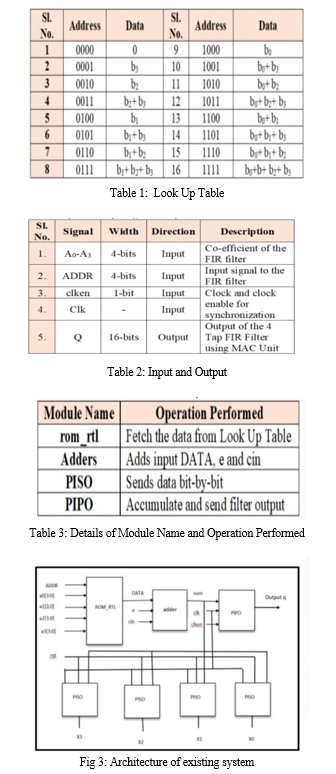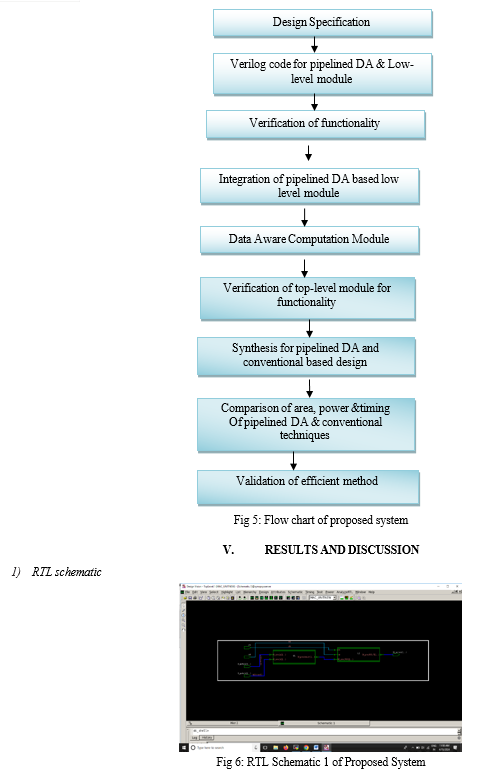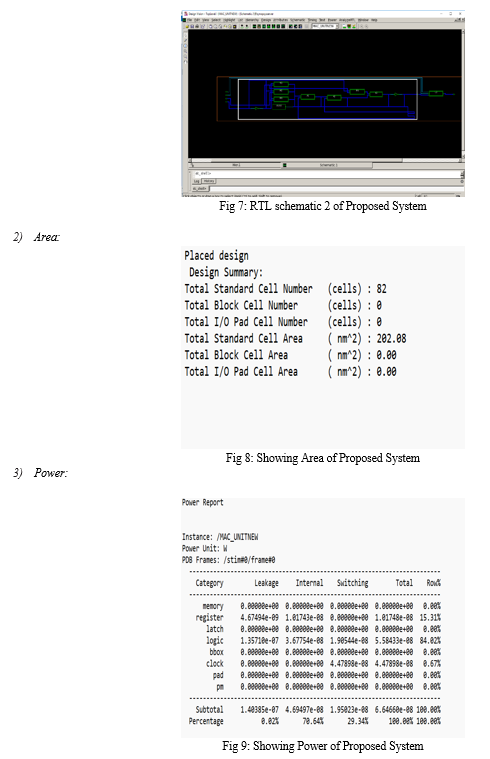Ijraset Journal For Research in Applied Science and Engineering Technology
- Home / Ijraset
- On This Page
- Abstract
- Introduction
- Conclusion
- References
- Copyright
Design and Implementation of FIR Filters for Biomedical Applications
Authors: Dr. T Kali Raja, B. Bharath Kumar Reddy, M. Sunny, C. Hemanth, C. Bhanu Prakash, C. Shyam Pavan Kumar
DOI Link: https://doi.org/10.22214/ijraset.2024.60615
Certificate: View Certificate
Abstract
Digital signal processing (DSP) greatly facilitates the continuous capture, monitoring, processing, and analysis of signals in real-world applications, particularly in biomedical or wearable devices. Within DSP systems, the design of Finite Impulse Response (FIR) filters is pivotal. In scenarios demanding intricate calculations and high precision, higher-order filters are employed. Multipliers are crucial components in filter design, consuming significant chip space and introducing extra computation overhead. Designers strive to optimize multipliers to enhance performance. In this project we are going to design pipelined based FIR filter by applying pipelining concept to the FIR filter and following the previous implementations such as the FIR filter with high accuracy compared to existing method. The proposed system architectures are known to be efficient for real signal processing, offering advantages over conventional based designs. The proposed design is anticipated to yield benefits in terms of area, power consumption, and timing performance. The synthesis and simulation of the existing and proposed designs are implemented using Cadence Virtuoso.
Introduction
I. INTRODUCTION
Multiplication operations are fundamental in various computational tasks, ranging from signal processing to scientific computing. However, these operations often come at a significant cost in terms of area consumption and critical path delay. In many applications, where a certain degree of error tolerance is acceptable, the use of advanced system has emerged as a promising approach to mitigate these challenges.
In this paper, we propose the design of a pipelined-based FIR filter for biomedical application, leveraging the concept of pipelining to enhance performance while maintaining a trade-off between area, timing, and accuracy. Building upon previous implementations, particularly focusing on the development of an FIR filter with superior accuracy compared to existing solutions, our objective is to create a FIR filter capable of meeting the stringent requirements of biomedical applications.
This proposed system offer the flexibility to adjust accuracy, time consumption, and area utilization to achieve higher performance compared to existing system. By incorporating pipelining into our design, we aim to further improve performance by parallelizing computation and reducing critical path delay.
Furthermore, our approach introduces an data aware computation module to meet our requirements. This is one of the important step towards achieving our requirements.
To mitigate the disadvantages that are introduced by existing system, we propose a system that can be helps to enhance area, power and timing efficiency.
Experimental results demonstrate the efficiency of our proposed designs. Compared to existing system our proposed system can achieves significant reductions in parameter values, highlighting its efficiency in terms of resource utilization. Moreover, when compared to non-pipelined FIR filter designs, the performance improvements afforded by our pipelined implementation are evident.
The synthesis and simulation of our proposed designs are facilitated using Cadence Virtuoso, providing a robust platform for development and optimization. Through rigorous synthesis and simulation processes, we validate the effectiveness and feasibility of our proposed approaches, paving the way for their practical implementation in various computational applications.
The organizational framework of this study divides the research work in the different sections. The Literature survey is presented in section 2. In section 3 and 4 discussed about the existing system and proposed system methodologies. Further, in section 5 the Results are discussed and Conclusion is presented by last section 6.
II. LITERATURE SURVEY
In 2021, Juthi Farhana Sayed et al.[1] proposed the Design and Evaluation of a FIR Filter Using Hybrid Adders and Vedic Multipliers. In this paper, FIR filter of 45nm technological node has been presented, which is a basic filter in DSP applications. Hybrid Adder has been introduced to improve cost and power consumption of the circuit. A Vedic multiplier and D-type register have also been introduced in the proposed FIR filter. 2-bit 4 tap direct and transposed form of FIR filter have been designed for computational data comparison. Results show that the hybrid adder design has almost 6 times lower power consumption than our conventional Adder using complementary CMOS logic. The smaller number of Delay elements of direct-from FIR further reduces power consumption, area and transistor numbers. Therefore, by using our circuits, the overall performance and power consumption of FIR filter has been improved significantly. To implement the circuits, DSCH software has been used and to design the layout, Microwind has been used.
In 2020, Swathi Dayanand et al.[2] proposed Low Power High Speed Vedic Techniques in Recent VLSI Design — A Survey. Advancement in the Artificial Intelligence (AI) and Machine Learning (ML) has influenced complex designs to be integrated in Very Large-Scale Integration (VLSI) Design. Designers are concentrating on high speed and low power techniques to facilitate the needs of the technology requirements. In multiple AI applications, Digital Signal Processor is the building block, optimization of it may solve the issues related to computation of the data signal at faster rate consuming less power using Vedic mathematics. In this paper, a detailed review is made on recent applications of Vedic Mathematics in the domain of VLSI to yield novel design, efficient architecture for Squarer, Multiplier, Arithmetic unit, Cubic and divider circuits along with their crucial performance criteria. It is deduced that the use of Vedic Sutras in formulating algorithms for digital logic circuit design has led to simplified architecture and yielded higher speed, low power consumption and enhanced efficiency of operation.
In 2020, M. Bharathi et al.[3] proposed Performance evaluation of Distributed Arithmetic based MAC Structures for DSP Applications MAC is an essential core which is used in every Digital signal processor. The primary focal point of this article is to introduce a high performance Distributed based (DA) MAC and offset binary coding Distributed Arithmetic (DA) based MAC for real time Signal Processing Applications. Addition and multiplication are the two hardware resources widely used to design any arithmetic blocks in many fields like video processing, audio processing, speech processing and medical image processing applications. In this article, a literature survey is done on different MAC [2] units with different multipliers to generate partial products and to perform accumulation.
Developed a DA based and offset binary coding DA based MAC cores which offers greater speed compared with different conventional MAC's using various multipliers. The coding for DA and offset based architectures are done using Verilog and simulation, synthesis are performed in Xilinx 14.7 Integrated Simulation Environment version. It achieves best area and less delay result when compared with previous approximate adder designs. The results of DA based MAC cores gives much more efficient in delay whereas offset binary coding-based DA offers both speed and area optimization.
In 2013, Ashish B. Kharate et al.[4] proposed VLSI Design and Implementation of Low Power MAC for Digital FIR Filter. In the majority of digital signal processing (DSP) applications the critical operations are the multiplication and accumulation. Multiplier-Accumulator (MAC) unit that consumes low power is always a key to achieve a high performance digital signal processing system. Finite impulse response (FIR) filters are widely used in various DSP applications. The purpose of this work is to design and implementation of Finite impulse response (FIR) filter using a low power MAC unit with clock gating and pipelining techniques to save power.
In 2011, Narendra singh Pal et al.[5] proposed Implementation of High Speed FIR Filter using Serial and Parallel Distributed Arithmetic Algorithm. This paper describes the implementation of highly efficient multiplier less serial and parallel distributed arithmetic algorithm for FIR filters. Distributed Arithmetic (DA) had been used to implement a bit-serial scheme of a general symmetric version of an FIR filter due to its high stability and linearity by taking optimal advantage of the look-up table (LUT) based structure of FPGAs. The performance of the bit-serial and bit-parallel DA technique for FIR filter design is analyzed and the results are compared to the conventional FIR filter design techniques. The proposed algorithm has been synthesized with Xilinx ISE 10.1i and implemented as a target device of Spartan3E FPGA.
III. EXISTING SYSTEM
In Very Large-Scale Integration (VLSI), the most popular bits' serial approach is Distributed Arithmetic (DA). In this approach the values are calculated in advance based on the number of address bits and stored in the database in the form of a lookup table (LUT) and these values are considered for the computation instead of resultant values from the multiplication.
The DA based design implementation on field programmable gate arrays (FPGAs) is easier and takes less computational time, but they are hindering due to excessive utilization of area when the bits increase.
This is the one of the main deciding factors to choose between the multiplier-based MAC or multiplier-less MAC. The entered coefficients are numbered concurrently and are used as input bits to the LUT; its end result is added to the gathered partial products.
To calculate the dot product, it makes use of N clocks where in N is the range of bits entered and is independent of the range of the entered variables. Figure 1 denotes the LUT based DA design architecture.



A data-aware computation module is a component within a system or algorithm that operates while being cognizant of the characteristics and structure of the data it processes. This module intelligently adapts its computation strategies based on the data it encounters, aiming to optimize performance, efficiency, and accuracy. Overall, a data-aware computation module combines adaptability, efficiency, and intelligence to perform computations optimally in various data-driven applications and scenarios.
Its ability to understand, adapt to, and leverage data characteristics makes it a crucial component in modern computing systems and algorithms. Pipelining and parallel processing are two techniques used in computer architecture and system design to improve performance and efficiency by overlapping and executing multiple tasks simultaneously. While they share the goal of enhancing throughput and reducing latency, they operate in different ways.
Pipelining is a technique where multiple tasks are divided into smaller stages, and each stage is executed concurrently.
The input data flows through the pipeline, with each stage processing a different part of the data simultaneously.
Once a stage completes its operation on one piece of data, it passes that data to the next stage without waiting for the entire process to finish. Pipelining reduces the overall processing time by overlapping the execution of different stages, effectively increasing throughput.
Common examples of pipelining include instruction pipelines in processors, where instructions are divided into fetch, decode, execute, and write-back stages, each operating concurrently on different instructions. Parallel processing involves the simultaneous execution of multiple tasks or computations using multiple processing units. Unlike pipelining, parallel processing executes independent tasks concurrently rather than breaking a single task into smaller stages.
Parallel processing can be achieved using multiple processors, cores within a processor, or specialized hardware accelerators. Tasks are distributed among the available processing units, and each unit operates independently on its assigned task.
Parallel processing offers significant performance gains for tasks that can be divided into parallelizable subtasks, such as large-scale simulations, data analytics, image processing, and scientific computations.
However, parallel processing may require synchronization and coordination mechanisms to manage data dependencies and ensure correct execution.
In summary, pipelining breaks a single task into smaller stages executed concurrently, while parallel processing involves executing multiple independent tasks simultaneously using multiple processing units. Both techniques aim to improve performance and efficiency by leveraging concurrency and overlapping execution.



This comparison table evaluates the performance of the existing and proposed systems for implementing FIR filter.
The parameters compared are area, power and timing consumption. Let’s discuss the meaning of each parameter and the comparison between the existing system and proposed system.
a. Area (in nm2): This parameter measures the amount of space required for implementing the FIR filter. It is typically measured in nm2. The existing system takes more area than proposed system. This suggests that the area efficiency is more in proposed system.
b. Power (in W): Power consumption measures the amount of electrical power consumed by the FIR filter during its operation. It is typically measured in watts (W). Despite the slight increase in power consumption, the proposed method's advantage in terms of timing might outweigh this increase, depending on the specific application's requirements.
c. Timing (in ps): This is the time it takes for the FIR filter to produce an output after receiving input. It is measured in picoseconds (ps). The existing system having more timing than the proposed system. This indicates that the proposed system offers improved speed performance compared to the existing system.
Overall, the proposed system seems to offer faster performance with comparable area efficiency but slightly higher power consumption compared to the existing system. The choice between the two systems would depend on the specific priorities of the design project, such as speed, power efficiency, or resource utilization etc.
VI. FUTURE SCOPE
The proposed system can be extended with further exploration of optimization techniques that can refine the proposed FIR filter design. This can be consist of using advanced blocks to achieve better performance metrics such as area, power consumption, and speed.
VII. ACKNOWLEDGMENT
It gives us great pleasure in presenting the preliminary project report on. I would like to take this opportunity to thank my guide Dr. T. Kali Raja, Ph.D., Professor and Dr. D. Srinivasulu Reddy, Ph.D., Professor, & Head of the Department (HOD) of Electronics and Communication Engineering, S V College of Engineering, Tirupati, Andhra Pradesh, India, for giving me all the help and guidance I needed. I am really grateful for their kind support and valuable suggestions were very helpful. Thank you all!
Conclusion
In conclusion, the proposed FIR filter design incorporating Data Aware Modules (DAMs) and pipelining techniques represents a significant advancement in digital signal processing. This innovative approach holds great potential for various applications, including communications, audio processing, and biomedical signal analysis, where real- time processing and high-performance filtering are paramount. By addressing the challenges of traditional FIR filter implementations, this proposal opens new avenues for advanced signal processing systems capable of meeting the demands of modern data-intensive applications. With further research and development, the integration of DAMs and pipelining techniques into FIR filter designs promises to revolutionize digital signal processing, unlocking new capabilities and performance benchmarks previously thought unattainable.
References
[1] N. Pal, H. Singh, R. Sarin, and S. Singh, “Implementation of High-Speed FIR Filter using Serial and Parallel Distributed Arithmetic Algorithm,” International Journal of Computer Applications, vol. 25, 07 2011. [2] Bharathi, M., Shirur, Y.J., & Lahari, P.L. (2020). Performance evaluation of Distributed Arithmetic based MAC Structures for DSP Applications. 2020 7th International Conference on Smart Structures and Systems (ICSSS), 1-5. [3] S. Dayanand, V. K R, R. T, Y. J. M. Shirur, and J. R. Munavalli, “Low Power High Speed Vedic Techniques in Recent VLSI Design — A Survey”, pices, vol. 4, no. 6, pp. 147-156, Oct. 2020. [4] Ashish B. Kharate and Prof. P.R. Gumble, “VLSI Design and Implementation of Low Power MAC for Digital FIR Filter”, International Journal of Electronics Communication and Computer Engineering Volume 4, Issue (2) REACT-2013, ISSN 2249—071X. June 2013, PP 604 — 605. [5] Juthi Farhana Sayed, Bhuiyan Hasibul Hasan, Babul Muntasir, Mehedi Hasan, Farhadur Arifin, “Design and Evaluation of a FIR Filter Using Hybrid Adders and Vedic Multipliers”, 2021 2nd International Conference on Robotics, Electrical and Signal Processing Techniques (ICREST). [6] D. Maskell, “Design of efficient multiplier less FIR filters,” IET Circuits, Devices & Systems, vol. 1, pp. 175—180(5), 2007. [7] Haw-Jing Lo, “Distributed Arithmetic” in Design of a reusable Distributed Arithmetic Filter and Its Application to The Affine Projection Algorithm” Georgia, UMI Microform, 2009, PP 3-12. [8] Xiumin Wang, “Implementation of FIR Filter on FPGA Using DAOBC Algorithm“ , in IEEE,2010. [9] Shunwen Xiao,Yajun chen, \"The design of FIR filter based on improved DA algorithm and its FPGA implementation \",IEEE International conference on computer and automation engineering(ICCAE’10), 2010,Vol.2,PP.589-591. [10] New Approach to Look-up-Table Design and Memory-Based Realization of FIR Digital Filter Pramod Kumar Meher, Senior Member, IEEE. [11] CHALLIS, R. E. andKITNEY, R. I. (1982) The design of digital filters for biomedical signal processing (in three parts). Part 1.J. Biomed. Eng.,4, 267–278. [12] CHALLIS, R. E. andKITNEY, R. I. (1983a) The design of digital filters for biomedical signal processing (in three parts). Part 2. —Ibid.,5, 19–30. [13] CHALLIS, R. E. andKITNEY, R. I. (1983b) The design of digital filters for biomedical signal processing (in three parts). Part 3. —Ibid.,5, 91–102. [14] Preeti D, Sasikala M, Gnana Prakash V, Satyasri B, Archana V “Performance Analysis of FIR Filters using High Speed VLSI Adders for FECG monitoring” 2023 9th international conference on smart structures and systems (ICSSS). [15] Design & implementation of FPGA based digital filters Ankit Jairath Department of Electronics & Communication, Gyan Ganga Institute of Technology and Sciences, Jabalpur (M.P) Issue 7, September 2012 199 All Rights Reserved © 2012 IJARCE.
Copyright
Copyright © 2024 Dr. T Kali Raja, B. Bharath Kumar Reddy, M. Sunny, C. Hemanth, C. Bhanu Prakash, C. Shyam Pavan Kumar. This is an open access article distributed under the Creative Commons Attribution License, which permits unrestricted use, distribution, and reproduction in any medium, provided the original work is properly cited.

Download Paper
Paper Id : IJRASET60615
Publish Date : 2024-04-19
ISSN : 2321-9653
Publisher Name : IJRASET
DOI Link : Click Here
 Submit Paper Online
Submit Paper Online

